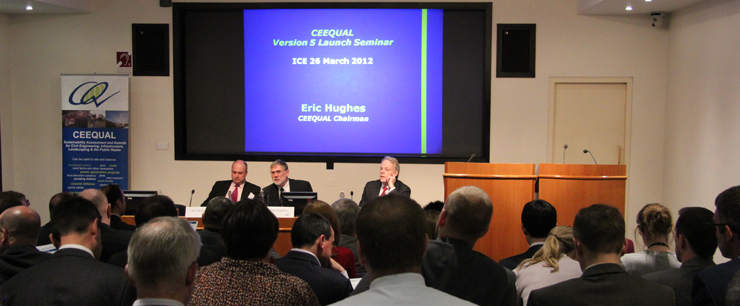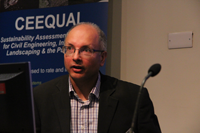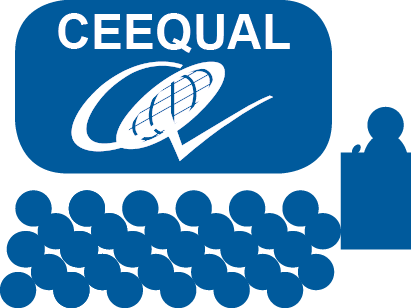Version 5 Launch - 26 March 2012 at the ICE, London
On Monday 26 March CEEQUAL launched its new Version 5 Methodology. This completes CEEQUAL’s transition from an environmental assessment and awards scheme to a sustainability and awards scheme. The Seminar covered: the development and features of
Version 5 (Ian Nicholson, CEEQUAL Technical Manager);
the brand new ‘Project Strategy’ section in the Assessment
Manual (Roger Venables, CEEQUAL Chief Executive); and
two practitioners’ perspectives of CEEQUAL from Crossrail
and Network Rail (Mike de Silva, Crossrail Sustainability
Manager; Tertius Beneke, Network Rail Environment Manager). |
|
The launch seminar was attended by people coming from as far as Argentina and online listeners ranged from New Zealand to Jordan.
|
Eric Hughes (centre in picture), CEEQUAL Chairman opened the afternoon event with an overview of progression since the original launch of CEEQUAL in 2004, followed by Award presentations to recipients of CEEQUAL’s first-ever International Projects Awards: • Trafikplats Jära
Gård: ‘Very Good’ Construction Only Award • Åkvarteren, Lomma
Hamn (Sweden): ‘Very Good’ Whole Project Award both accepted by Gustav Larsson (left in picture), Environmental and CEEQUAL Coordinator, Skanska Sweden; and Gary Rogerson (on the right), Environmental Manager, Skanska UK. |
Development and features of Version 5
Ian Nicholson began his presentation with an overview of what CEEQUAL can offer (including Term Contracts, Types of Awards available and the benefits of CEEQUAL). He then explained how Version 5 was different to Version 4, with primary changes being: improved coverage of questions, consolidation of the previous twelve sections into nine, better consistency between sections, raising the bar in areas of the Assessment and finally mentioning the brand-new ‘Project Strategy’ section (explained in full later by Roger Venables – see below).He then explained how the Online Assessment Tool has been upgraded, with brand-new features such as: ‘read-only’ user access, central document location, Assessment report and new discussion forum where Assessors can discuss issues experienced on projects. Ian concluded with an brief explanation that current Version 4 (or earlier) would have to go through a free Version 5 upgrade Assessor training course before undertaking a project under Version 5.
Brand-new ‘Project Strategy’ section in the Assessment Manual
Roger Venables opened with an explanation of why Project strategy was added to the CEEQUAL Methodology: “trigger project teams to look at their project in a wider scope... look at it in a sustainability point of view... and to challenge them to ask themselves on whether they are carrying out a ‘good’ project.”He went on to explain what Project Strategy covers (such as: wider economic benefits, social impact assessments, improving quality of life, EIA, resource strategy and life cycle assessments, and lastly pathway contribution). Roger explained the applicability of the new section and that it would be more applicable to Whole Project and Whole Project with Interim Awards. But the Section includes Construction Strategy, so the section is applicable to all partial awards too.
He concluded that “CEEQUAL’s aim with the inclusion of the new ‘Project Strategy’ section is to complete CEEQUAL’s transition from an environmental assessment and awards scheme to a sustainability assessment, rating and awards scheme.”
A Practitioner's View of CEEQUAL:Mike de Silva - 'Crossrail and CEEQUAL' Mike started with an introduction of the background to the Crossrail projects (including 21km of 6.2m diameter twin-bore tunnel, one major refurbishment, and tunnel packages). He then explained that CEEQUAL’s (previous) twelve sections were very similar in part (and overlapped each other in areas) to Crossrail’s sustainability themes in their sustainability strategy. Through comparison of CEEQUAL’s sub-headings and Crossrail’s sustainability themes, Crossrail found that there was a significant overlap, and it was therefore concluded that CEEQUAL would be the ideal tool to manage and monitor Crossrail’s performance. Crossrail has applied for a Whole Project with Interim Award. Crossrail has decided that the Interim verifications for the subprojects are to occur during the RIBA D + stage of design. All their subprojects have received an ‘Excellent’ rating at this stage. Mike went on to say “We are very pleased with this outcome but are conscious there is still a long way to go with the construction of the project.” After a further in depth look at their projects under assessment, Mike started to conclude his practitioner’s view with benefits of CEEQUAL by Crossrail, which included: providing an established benchmark of performance, rigor and consistency to the analysis, helps create a competitive tension and enables linkage of CEEQUAL assessment to other contractor performance metrics – balanced scorecards. Mike ended his talk with a view of ‘Lessons learned by Crossrail’ and what he would like to see in CEEQUAL in the future, which includes: development into a more balanced sustainability tool (“As you can see from the previous presentations from Ian Nicholson and Roger Venables I do think that CEEQUAL is beginning to move into this direction”) and readjustment of the rating threshold (“I am delighted to hear that in Version 5 this is indeed the case”).
|
|
Tertius Beneke- 'Network Rail's experience of using CEEQUAL on Crossrail' Tertius opened with a broad description of the Crossrail surface works (including 27 station upgrades, 61km of track, 1,000 overhead line equipment structures) – delivered by Network Rail – with Crossrail’s decision to specifically use CEEQUAL. “Always helpful when you have a strong client who, not only specifies for a CEEQUAL Assessment but helps push the agenda. We also have the Crossrail Act 2008 in place which outlines the minimum Environmental Requirements and the construction code for the project.” The subprojects selected to undergo the CEEQUAL Assessment was decided with the client and CEEQUAL. these projects (for example Acton) captures the majority of works delivered by Network Rail and how they assess the works. Tertius explained that the CEEQUAL process would be onerous if all packages were assessed and the benefits of using CEEQUAL would have been lost due to the copious workload. “These projects, in regards to CEEQUAL, are nice discreet civil engineering projects: you can draw a boundary around them and they are one type of civil engineering project”. Tertius concluded the talk with Network Rail’s benefits from using CEEQUAL, which included: helped drive the EMS, CEEQUAL sets targets for the Project Manager to achieve, gives visibility of our commitment to sustainability and sets the standard within Network Rail, and gives Network Rail that more competitive edge in the growing commercial world. “CEEQUAL is embedding sustainability into the way Network Rail delivers its investment projects. I believe that CEEQUAL will feature strongly in Network Rail’s future projects. I do think CEEQUAL is indeed contributing to moving society on a pathway towards sustainable living.” Click
here to download full transcript of Tertius’s practitioner’s
view by Network Rail. Q&A DiscussionClick here to download Q&A transcript. Three more projects Awards were presented by Eric Hughes after the discussion part of the Seminar and compromised of: |
|
•
M25 DBFO Section 4b, Junctions 28 to 29: ‘Excellent (79.6%)’
Interim Client & Outline Design Award • M25 DBFO Section 6
Hatfield Tunnel Refurbishment: ‘Excellent (75.5%)’ Whole Project
Award • M25 DBFO Junctions
1y, Junctions 18 to 21a: ‘Excellent (87.2%)’ Whole Project
Award |
 |
The Seminar concluded with a round of applause and refreshments.
We thank everyone who attended and also to those who listened online (especially to those in different time zones!).






